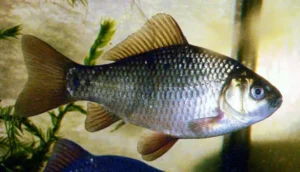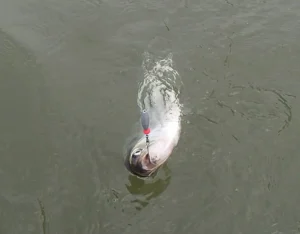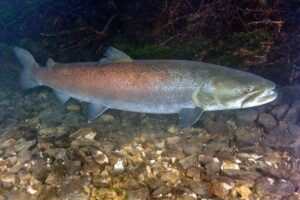Game fish: Brown Trout (Salmo trutta fario)

The Brown Trout, an iconic fish of our rivers, is highly prized by sports fishermen.
Also known as Salmo trutta, this species of fish can reach a maximum size of about 1 meter and weigh up to 10 kg (22 lbs). The Brown Trout is characterised by a speckled coat that varies depending on its environment and age.

What is Brown Trout (Salmo trutta fario)?
The Brown Trout (Salmo trutta fario) is a freshwater fish from the Salmonidae family, also known as River Trout. The Brown Trout is a widespread species in the rivers and lakes of Europe. It is characterised by its speckled coat that varies depending on its environment and age. Sports fishermen highly appreciate the Brown Trout for its combativeness and tasty flesh. It can be fished with fly, lure, or natural bait.
Description of the Brown Trout (Salmo trutta fario)
Identification
The Brown Trout is a freshwater fish from the Salmonidae family. Its body is fusiform and elongated, and can reach a maximum length of 1 meter. Its head is small and elegant, with a wide mouth and a prominent lower jaw. The eyes of the Brown Trout are golden and are positioned high on the head.
It differs from Salmon by its more modest size and finer, elongated body. The dorsal, anal, and caudal fins of the Brown Trout have soft rays and spiny rays and are edged with a characteristic white border.
The brown trout’s body colour varies from grey-green to golden brown, with silvery reflections. Its body has black or red spots, which are more or less numerous and visible depending on the individual’s age and environment. The fins are often edged with bright red.
It is important to note that several subspecies of Brown Trout have morphological and ecological differences. The Brown Trout (Salmo trutta fario) can thus be distinguished from the Sea Trout (Salmo trutta trutta), which is an anadromous subspecies, i.e., it reproduces in freshwater but migrates to sea to feed. The Sea Trout can thus reach a size and weight much greater than the Brown Trout. Finally, the Lake Trout (Salmo trutta lacustris) is a subspecies that reproduces exclusively in freshwater, lakes, and large reservoirs. It can also reach a significant size and weight but is distinguished from the Brown Trout by its more stocky morphology and smaller and less numerous spots.
| Class |
| Actinopterygii |
| Order |
| Salmoniformes |
| Family |
| Salmonidae |
| Genus |
| Salmo |
| Species |
| S. trutta |
| Binomial Name |
| Salmo trutta fario (Linnaeus, 1758) |
Size and Weight
The Brown Trout can reach a maximum size of about 1 meter and weigh up to 10 kg. Its growth depends on water quality, food availability, and population density. On average, the Brown Trout measures between 20 and 50 cm (7.9-19.7 inches) and weighs between 1 and 3 kg (2.2-6.6 lbs). The world record for Brown Trout caught is 22 kg (48.5 lbs) for a length of 1.2 meters.
Lifespan
The average lifespan of the Brown Trout is about 10 to 12 years, but some populations can live up to 20 years.
Habitat and Lifestyle
Habitat of the Brown Trout
The Brown Trout (Salmo trutta fario) is a freshwater fish species found in Europe and Western Asia’s rivers, lakes, and streams. It is also present in some regions of North Africa, North America (notably California, Montana, and Colorado) and South America, where man introduced it.
The Brown Trout is a very adaptable species and can live in various aquatic habitats. It is thus found in fast-flowing rivers, calm waters of lakes, and mountain streams. It prefers clear and well-oxygenated waters but can survive in less oxygen-rich waters.
Diet
The Brown Trout (Salmo trutta fario) is a carnivorous fish that feeds primarily on aquatic invertebrates, such as mosquito larvae, mayflies, caddisflies, and molluscs. It also feeds on small fish, frogs, and mammals when available in its environment.
The diet of the Brown Trout is closely related to the characteristics of its environment. Thus, in insect-rich waters, it feeds mainly on aquatic invertebrates, while in rivers with a high density of fish, it hunts more small fish.
Fishermen can use this diet to capture the Brown Trout. Indeed, by using lures or baits that mimic the natural prey of the Trout, it is possible to attract the fish and capture it. The most commonly used lures for fishing for Brown Trout are imitations of mosquito larvae, mayflies, or small fish. Natural baits such as earthworms, mosquito larvae, or snails can also be very effective.
Reproduction
Brown Trout (Salmo trutta) reproduces yearly in mountain watercourses and rivers. Its reproduction begins in autumn when the waters calm and the days shorten. Females lay their eggs in gravel nests, called redds, that the males have previously prepared. The males fertilise the eggs and cover them with gravel to protect them.
The eggs of the Brown Trout hatch generally after 4 to 6 weeks, depending on the water temperature. The fry hatch with a yolk sac that allows them to survive without food for their first few days of life. Once the yolk sac is absorbed, the fry feeds on tiny aquatic organisms.
The Brown Trout reaches sexual maturity at 2 to 4 years, depending on populations and environmental conditions. Females can lay up to 3,000 eggs per breeding season.
Reasons why fishermen prize the Brown Trout
Firstly, the Brown Trout is a combative fish that offers good resistance when caught. Fishermen thus appreciate the challenge it represents and the feeling of fighting against a powerful fish.
Secondly, Brown Trouts feed on a wide variety of foods, making them easily attracted by different types of baits and lures. Fishermen thus have a wide choice for capturing this fish, depending on the environment and fishing conditions.
Furthermore, the Brown Trout is a fish in many rivers and lakes, making it accessible to many fishermen. It can thus be fished in the mountains and plains and does not require specific equipment.
Finally, the Brown Trout is a tasty fish, appreciated by gastronomy enthusiasts. Its flesh is delicate and savoury and can be prepared in many ways.
However, it is essential to remember that fishing for Brown Trout must be practised responsibly and sustainably to preserve the populations of this fish in our watercourses. Fishermen must respect the quotas and fishing rules in force and the minimum catch sizes. They must also release small fish or those caught accidentally.
Common name for the Brown Trout (Salmo trutta fario)
Most popular common names for the Brown Trout are Truite fario (french), Forelle (german), Trota fario (italian). Trucha común (Spanish) and Troć (Polish).
Fishing Techniques for the Brown Trout
The most commonly used technique for fishing for Trout is fly fishing. This technique involves using a special fishing rod called a fly rod and an artificial fly that imitates the insects and other natural prey of the Brown Trout. Fly fishing is a demanding technique that requires good mastery of the casting technique and good knowledge of the habits and behaviours of the Brown Trout.
Lure fishing is also a popular technique for catching Brown Trout. It involves using artificial lures, such as spoons, soft baits, or swimbaits, to attract the Trout and capture it. This technique is less demanding than fly fishing but requires knowledge of the trout’s feeding habits and a good casting technique.
Finally, fishing with natural baits is a traditional technique that involves using live or dead baits, such as earthworms, mosquito larvae, or snails, to attract and capture brown trout. This technique is relatively simple and accessible but still requires good knowledge of the trout’s feeding habits and the environment in which it evolves.
Conservation Status of the Brown Trout (Salmo trutta fario)
The Brown Trout is classified in the category LC (Least Concern) in the IUCN Red List. The “Least Concern” category corresponds to a species that is widely distributed and abundant.






